Table Of Contents
Moss on roofs can pose significant issues beyond mere aesthetic concerns; if left unaddressed, it may result in serious structural damage. This article examines the various causes of moss growth, the critical importance of roof moss removal, and the most effective methods for roof cleaning. Additionally, it outlines essential safety precautions and alternative removal techniques to ensure the protection of both the home and its surroundings, with insights from home maintenance experts. By the conclusion of this article, readers will possess the necessary knowledge to maintain their roofs in a moss-free and optimal condition, preventing moss growth and extending their roof lifespan.
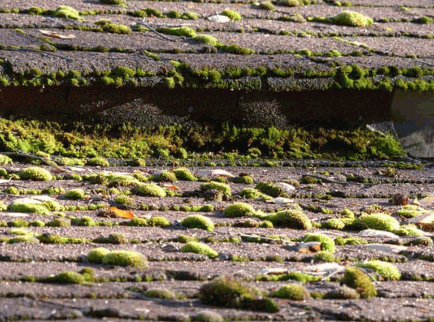
What Causes Moss To Grow On Roofs?
Moss growth on roofs is primarily attributed to a combination of moisture, shade, and an environment that supports organic growth, particularly impacting residential roofs in regions such as Connecticut, Colorado, and the Pacific Northwest.
When shingles retain moisture due to inadequate sunlight and ventilation, it creates an optimal habitat for moss proliferation, which can compromise the roof's structural integrity. This growth not only diminishes the aesthetic appeal of the home but also results in long-term damage if appropriate preventive measures are not taken.
Therefore, understanding the underlying causes is essential for effective moss removal and comprehensive roof maintenance.

Why Is It Important To Remove Moss From Roofs?
Removing moss from roofs is essential for preserving the structural integrity and longevity of roofing materials. Unchecked moss growth can result in moisture retention, which damages shingles and promotes wood rot, potentially compromising the overall structure of the roof.
Over time, the presence of moss can lead to various significant issues. It not only fosters an environment conducive to lingering moisture but can also contribute to the deterioration of roof underlayment. As moss continues to proliferate, it may lift shingles, creating openings that allow rainwater to infiltrate, resulting in potential leaks within the home. Such leaks can lead to costly water damage and mold growth, underscoring the importance of regular roof maintenance.
Engaging in a professional cleaning service provides substantial benefits. Utilizing specialized techniques and tools, experts can effectively remove moss without causing harm to the roofing materials, ensuring a comprehensive cleaning that extends the roof's lifespan.
Key practices to consider include:
- Regularly scheduled inspections to detect moss early.
- Cleaning to restore both the aesthetic and functional aspects of the roof.
- Preventing costly repairs in the future.
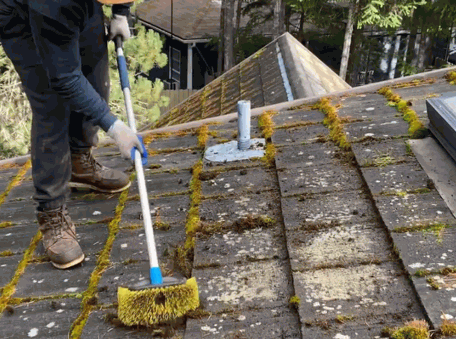
How To Clean Moss From Roofs?
The removal of moss from roofs can be achieved through a range of methods, encompassing both do-it-yourself solutions and professional cleaning services. Effective removal typically requires the preparation of a cleaning solution, which is then applied directly to the affected areas, followed by scrubbing and rinsing to ensure comprehensive treatment.
Additionally, homeowners should consider implementing preventive measures to inhibit future moss growth, thereby enhancing the longevity of their roofs.
Safety Precautions
Prioritizing safety precautions is essential when undertaking roof cleaning, particularly during the removal of moss, to prevent accidents that could result in serious injuries. Homeowners should utilize appropriate protective gear, such as harnesses, non-slip footwear, and goggles, to create a secure working environment while addressing moss on their roofs.
Plus the use of protective gear, it is critical to implement appropriate ladder safety protocols to minimize the risk of falls. Ensure that the ladder is positioned on a stable, even surface and at the correct angle for safe ascent. Before initiating any cleaning tasks, it is advisable to assess the weather conditions, as wet or windy days can render the roof dangerously slippery.
- Utilize roof anchors or safety ropes for added security.
- Maintain awareness of the surroundings and avoid working near overhanging branches or power lines.
Protecting the area below the working zone is vital; it is prudent to place tarps or drop cloths to catch falling debris, thereby safeguarding landscaping and exterior features.
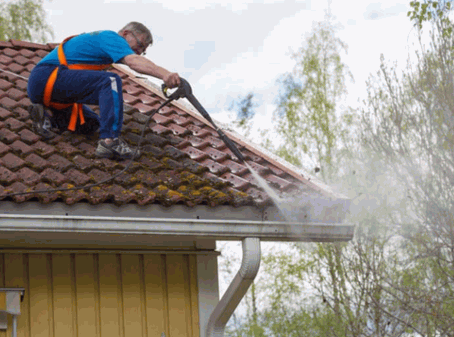
Gather The Necessary Tools And Materials
Before initiating the moss removal process, it is essential to gather all necessary tools and materials. This may include a scrub brush, a garden sprayer for applying DIY moss removal solutions, and a ladder to ensure safe access to the roof. Having these essentials readily available not only streamlines the cleaning procedure but also enhances safety and efficiency.
To ensure a successful moss removal and prevent future algae growth, consider incorporating the following essential tools and materials into your preparation:
- Trisodium Phosphate (TSP): This powerful cleaning agent, such as BioAdvanced Moss and Algae Killer, effectively breaks down moss and algae, facilitating easier scrubbing.
- Distilled White Vinegar: As an eco-friendly alternative, distilled white vinegar works effectively against organic growth, naturally killing moss while providing a mildly acidic rinse.
- Protective Gear: Gloves and goggles are crucial for safeguarding the skin and eyes from cleaning chemicals.
- Hose or Pressure Washer: Once the scrubbing is complete, a thorough wash will eliminate any remaining residue.
These items, when prepared in advance, not only enhance the effectiveness of the cleaning process but also contribute to a safer working environment, ensuring that each session is both productive and less hazardous.
Clear Debris And Loose Moss
To effectively remove moss from roofs, it is imperative to begin by clearing away any debris and loose moss. This initial step prepares the surface for the application of cleaning solutions and ensures better adherence to the moss killer. Proper preparation is essential for achieving optimal results.
Before applying any cleaning agents, it is crucial to remove all types of debris, including leaves, branches, and dirt. This not only creates a more accessible surface for the cleaning process but also minimizes the risk of conditions that may allow moss to thrive in any remaining organic materials. By dedicating time to the following actions:
- Clear away fallen leaves
- Remove small branches that may obstruct the cleaning process
- Shovel dirt accumulated in roof valleys
one can significantly enhance the effectiveness of subsequent cleaning measures, leading to a longer roof lifespan. This thorough preparation also reduces the likelihood of future moss growth, as these remnants tend to retain moisture, thereby creating an ideal environment for moss proliferation.

Apply Moss Killer Solution
Applying a moss-killer solution is a crucial step in the roof cleaning process, as it effectively targets moss growth. This can be achieved through the use of either a commercial chemical solution or a DIY moss remover composed of natural ingredients.
Proper handling of the application process can significantly enhance the effectiveness of moss removal efforts. It is essential to read and adhere to the manufacturer's instructions for any chemical solutions, as each product may contain specific guidelines regarding dilution ratios, application techniques, and safety precautions.
For example, some products may necessitate mixing with water prior to application, while others are designed for immediate use. Environmentally conscious homeowners may opt for organic alternatives, which can be equally effective without posing a risk to surrounding plant life.
Applying moss killer during dry weather conditions is recommended, as it greatly improves absorption and overall effectiveness, leading to better results in addressing unsightly patches. By following these application strategies, individuals can ensure a more efficient and thorough removal of moss, thereby contributing to the longevity and aesthetic appeal of the roof.
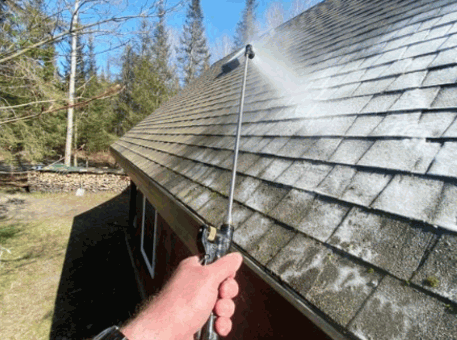
Scrub And Rinse The Roof
Once the moss killer solution has been adequately applied, the subsequent step involves gently scrubbing the roof to remove any remaining moss, followed by rinsing with water to eliminate debris and cleaning residues, thereby ensuring a comprehensive treatment.
During this critical phase, it is imperative to utilize a soft-bristle brush or a non-abrasive sponge, as the use of harsh scrubbing tools may damage the shingles and compromise their structural integrity. The process should begin at the top of the roof and progress downward in small sections, applying light pressure. This approach not only facilitates the removal of moss but also minimizes the risk of dislodging any shingles.
- Patience and persistence are essential, as the objective is to achieve complete removal without causing damage.
- Following the scrubbing process, it is vital to rinse the area thoroughly. This step is not merely an afterthought; it effectively eliminates any residual cleaning solution, which could leave unwanted residues if not properly washed away.
- Employ a garden hose equipped with a spray attachment to enable a more controlled and effective rinsing process, ensuring that every bit of debris is flushed away.
Successfully completing this cleaning technique will restore the roof’s health, providing lasting protection and enhancing its overall appearance, ultimately preserving the roof's integrity.
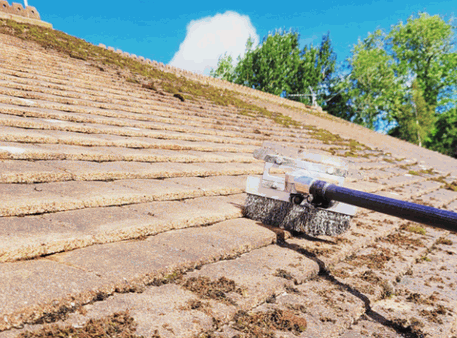
Prevent Future Moss Growth And Maintain Roof Structure
To prevent future moss growth on residential roofs, homeowners should implement a series of preventive measures, including regular roof maintenance, ensuring adequate water drainage, and considering the installation of zinc strips or roof strips that inhibit the growth of moss and algae. Incorporating a DIY moss remover can also be an effective strategy.
Conducting routine inspections of the roof can assist in identifying potential problem areas before they develop into more serious issues. Trimming overhanging branches is also an effective strategy, as it reduces shade and prevents the accumulation of debris, which can trap moisture and promote moss growth.
Additionally, maintaining proper ventilation is essential for facilitating airflow that dries moist areas, ultimately protecting the roof from decay and structural damage.
Each of these strategies significantly contributes to prolonging the lifespan of the roof and preserving its overall integrity, thereby allowing homeowners to enjoy their roofs without concerns regarding unwanted growth or damage.
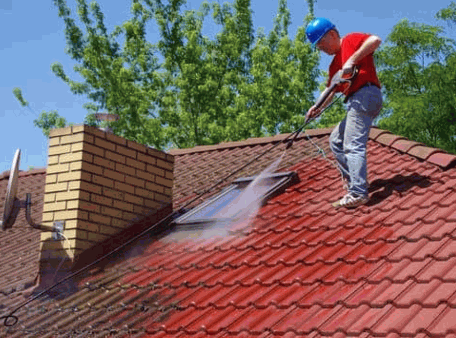
What Are The Alternative Methods For Removing Moss From Roofs?
There exist several alternative methods for the removal of moss from roofs, each with its own advantages and disadvantages. These methods, often discussed in Home Improvement Ideas forums, include:
- Pressure washing
- Chemical treatments, such as those using BioAdvanced Moss and Algae Killer or Trisodium phosphate
- Manual removal
These options enable homeowners to select the most appropriate option based on their individual circumstances.
Pressure Washing
Pressure washing is an effective method for removing moss, as it utilizes high-pressure water to dislodge moss and algae; however, it requires caution to avoid damaging shingles or compromising the integrity of the roof structure.
Plus being a powerful tool for cleaning surfaces, pressure washing provides numerous advantages for homeowners seeking to enhance the appearance of their properties. Employing this technique can effectively restore driveways, decks, and patios by eliminating accumulated debris, grime, and persistent organic growth.
It is essential to acknowledge the potential risks involved. For instance, improper use of pressure settings may lead to gouging or deterioration of sensitive materials. Therefore, it is advisable to:
- Test the pressure on a small, inconspicuous area first.
- Adjust the nozzle accordingly to manage the spray width.
- Utilize safety gear, including goggles and gloves, to protect oneself from debris.
While pressure washing can significantly improve the aesthetic appeal of various outdoor spaces when applied correctly, understanding its techniques and implementing appropriate safety measures can help mitigate risks and safeguard one's investment.
Find out more: How To Clean External Cladding
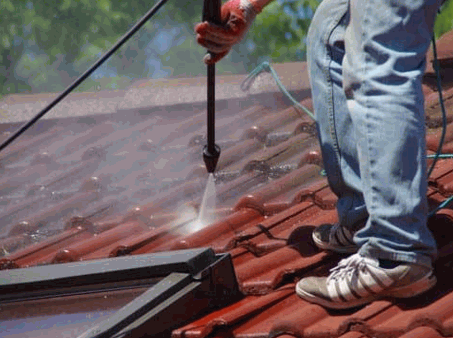
Chemical Treatments
Chemical treatments for moss removal utilize specially formulated solutions designed to eliminate moss and prevent its regrowth. However, homeowners should exercise caution and select eco-friendly options, such as DIY solutions like vinegar and baking soda, to minimize environmental impact.
When determining the appropriate approach, it is imperative to consider not only the effectiveness of the chemical in eradicating moss but also its safety for the surrounding flora and fauna. Consequently, numerous solutions available in the market present specific advantages:
- Organic Solutions: These are derived from natural ingredients and pose minimal risk to the environment while effectively controlling moss growth.
- Chemical Herbicides: While potent, these substances should be employed judiciously and in accordance with application instructions to avoid causing harm to nearby plants.
- Homemade Treatments: Common household items such as vinegar and baking soda can deter moss but may necessitate more frequent applications.
Regardless of the selected method, adhering to application guidelines is essential for achieving successful outcomes while protecting the surrounding landscape.
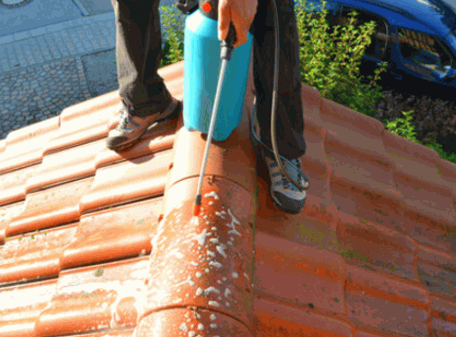
Manual Removal
Manual removal of moss entails the physical scraping of moss from the roof surface using brushes or scrapers. This method can be effective; however, it requires careful attention to avoid damaging the shingles and to ensure thorough removal of the moss.
To execute this task effectively, it is essential to use appropriate tools, such as a stiff-bristled brush, a plastic scraper, or a pressure washer set to a low setting. Ahead of commencing the work, it is critical to observe safety precautions, including the use of a sturdy ladder, wearing non-slip footwear, and securing the work area to prevent accidents.
- Benefit: Manual removal offers a hands-on approach, allowing for greater control over the integrity of the roof.
- Drawback: This method can be labor-intensive and time-consuming when compared to chemical treatments or professional services.
By carefully evaluating the benefits and drawbacks of manual removal, homeowners can make informed decisions that align with their needs and preferences while effectively maintaining their roofs.

What Precautions Should Be Taken When Cleaning Moss From Roofs?
When removing moss from roofs, it is essential to take specific precautions to ensure a safe and effective process. This includes utilizing appropriate protective gear, being mindful of the surrounding environment, and avoiding harsh chemicals that may damage roofing materials or nearby vegetation.
Use Protective Gear
Using appropriate protective gear is essential when cleaning roofs to safeguard against potential hazards, such as falls and exposure to chemicals. This practice ensures a safer working environment while addressing issues related to roof moss.
Prioritizing safety during such tasks not only minimizes the risk of injury but also enhances overall efficiency. Protective gear encompasses a variety of items specifically designed for this purpose:
- Harnesses: These are critical for preventing falls, as they allow individuals to work at heights while remaining securely attached to the roof.
- Gloves: Designed to protect hands from harsh cleaning chemicals and sharp roofing materials, gloves are a necessary component of the protective gear.
- Goggles: By protecting the eyes from splashes or debris, goggles ensure that vision remains clear and unobstructed throughout the cleaning process.
Consistently employing this gear will foster a safer working environment and promote the well-being of those engaged in roof cleaning activities.

Be Mindful Of Surrounding Plants And Animals
It is essential to be mindful of surrounding plants and animals during the moss cleaning process, as certain chemicals and debris can inadvertently harm vegetation and wildlife. Therefore, selecting environmentally friendly cleaning solutions is of paramount importance.
Protecting the local ecosystem should always be a priority, particularly when conducting maintenance tasks such as roof cleaning. Many chemicals employed in traditional cleaning methods have the potential to seep into the soil and waterways, contributing to pollution and posing a threat to local biodiversity.
To minimize this impact, consider the following recommendations:
- Opt for biodegradable cleaning products that break down naturally and do not leave harmful residues.
- Utilize gentle scrubbing techniques to remove moss instead of high-pressure washing, which can dislodge debris and cause damage to nearby plant life.
- Whenever possible, cover adjacent plants and areas with tarps to shield them from falling debris and chemical runoff.
- Schedule cleaning during dry weather to reduce the likelihood of chemicals reaching the soil.
By implementing these precautions, individuals can effectively remove moss while preserving the delicate balance of the surrounding ecosystem.
Avoid Using Harsh Chemicals
To safeguard both the roof and the surrounding environment, it is advisable to refrain from using harsh chemicals like chlorine bleach during moss cleaning. Instead, one should opt for biodegradable and safe cleaning solutions, such as DIY moss removers, that effectively eliminate moss without causing any damage.
The use of harsh chemical solutions can lead to the long-term degradation of roofing materials, thereby compromising their integrity and lifespan. Additionally, these chemicals may enter gutters and stormwater systems, posing significant risks to local ecosystems. Research has demonstrated that runoff from roofs treated with toxic cleaning agents can contaminate nearby water bodies, adversely affecting aquatic life.
To mitigate such risks, it is prudent to consider alternatives that prioritize both effectiveness and safety:
- Vinegar-based solutions: These natural acids can effectively break down moss while remaining gentle on surfaces.
- Baking soda: This common household item can disrupt moss growth, providing a safe and non-toxic option.
- Pressure washing: Utilizing controlled pressure, this method can remove moss without the need for chemicals.
By transitioning to these environmentally friendly options, one can ensure a cleaner roof and a healthier surrounding area.
How Often Should Roofs Be Cleaned From Moss?
Regular roof cleaning to remove moss is essential for maintaining the integrity of a home. It is recommended that roofs be inspected and cleaned at least once a year, with increased frequency in areas that experience high moisture and moss growth. Using a DIY moss remover can also be effective in keeping your roof free from moss.
Several factors significantly influence the optimal frequency of roof cleaning. For instance, the regional climate plays a critical role in moss proliferation, as regions characterized by prolonged wet seasons or elevated humidity levels create favorable conditions for moss development. In regions such as the Pacific Northwest, where moisture levels are consistently high, moss growth can be a persistent issue.
The material of the roof also affects maintenance frequency; different materials may necessitate distinct care routines and can vary in their susceptibility to moss accumulation. For example, residential roofs made of asphalt shingles may require different care than those made of metal. Furthermore, the proximity of trees can lead to the accumulation of debris on the roof, which promotes moisture retention and encourages moss growth.
Implementing preventive measures, such as conducting regular inspections and trimming overhanging branches, is essential for minimizing the frequency of required cleanings. Installing zinc strips on your roof can also help to prevent moss from growing.



